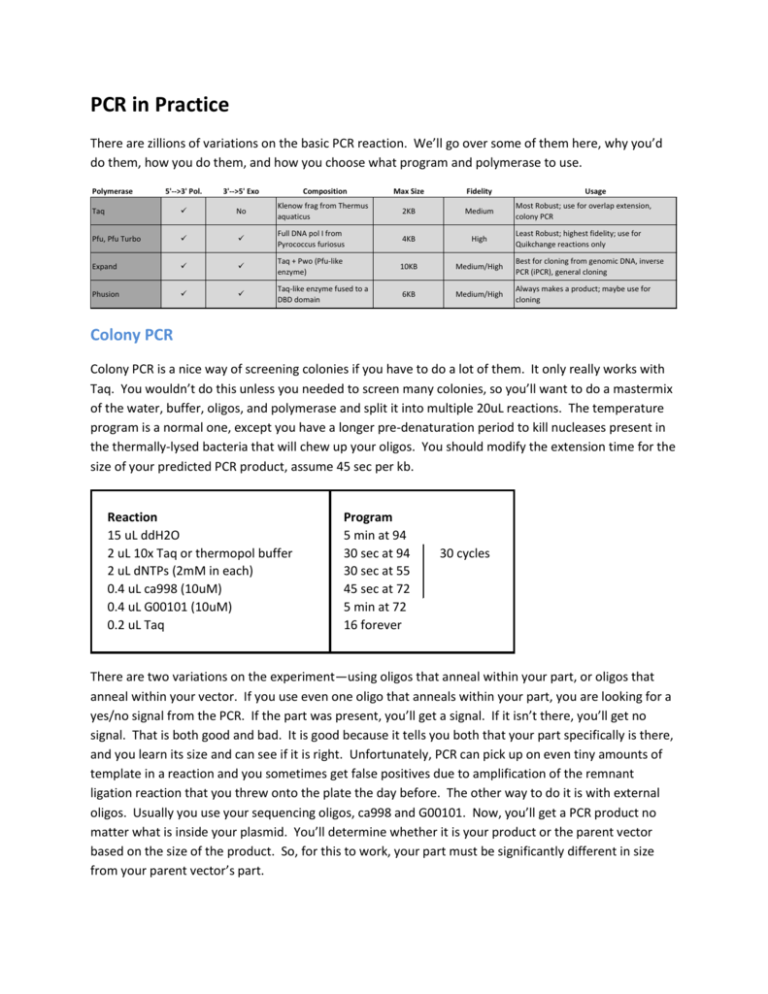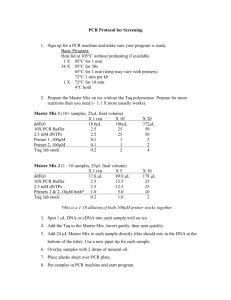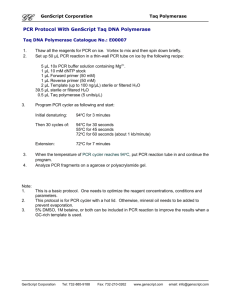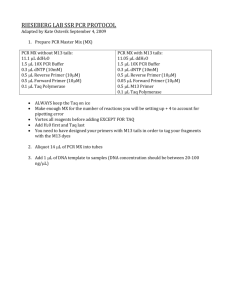PCR+in+Practice
advertisement

PCR in Practice There are zillions of variations on the basic PCR reaction. We’ll go over some of them here, why you’d do them, how you do them, and how you choose what program and polymerase to use. Polymerase 5'-->3' Pol. 3'-->5' Exo Composition Max Size Fidelity 2KB Medium Usage Taq No Klenow frag from Thermus aquaticus Most Robust; use for overlap extension, colony PCR Pfu, Pfu Turbo Full DNA pol I from Pyrococcus furiosus 4KB High Expand Taq + Pwo (Pfu-like enzyme) 10KB Medium/High Best for cloning from genomic DNA, inverse PCR (iPCR), general cloning Phusion Taq-like enzyme fused to a DBD domain 6KB Medium/High Always makes a product; maybe use for cloning Least Robust; highest fidelity; use for Quikchange reactions only Colony PCR Colony PCR is a nice way of screening colonies if you have to do a lot of them. It only really works with Taq. You wouldn’t do this unless you needed to screen many colonies, so you’ll want to do a mastermix of the water, buffer, oligos, and polymerase and split it into multiple 20uL reactions. The temperature program is a normal one, except you have a longer pre-denaturation period to kill nucleases present in the thermally-lysed bacteria that will chew up your oligos. You should modify the extension time for the size of your predicted PCR product, assume 45 sec per kb. Reaction 15 uL ddH2O 2 uL 10x Taq or thermopol buffer 2 uL dNTPs (2mM in each) 0.4 uL ca998 (10uM) 0.4 uL G00101 (10uM) 0.2 uL Taq Program 5 min at 94 30 sec at 94 30 sec at 55 45 sec at 72 5 min at 72 16 forever 30 cycles There are two variations on the experiment—using oligos that anneal within your part, or oligos that anneal within your vector. If you use even one oligo that anneals within your part, you are looking for a yes/no signal from the PCR. If the part was present, you’ll get a signal. If it isn’t there, you’ll get no signal. That is both good and bad. It is good because it tells you both that your part specifically is there, and you learn its size and can see if it is right. Unfortunately, PCR can pick up on even tiny amounts of template in a reaction and you sometimes get false positives due to amplification of the remnant ligation reaction that you threw onto the plate the day before. The other way to do it is with external oligos. Usually you use your sequencing oligos, ca998 and G00101. Now, you’ll get a PCR product no matter what is inside your plasmid. You’ll determine whether it is your product or the parent vector based on the size of the product. So, for this to work, your part must be significantly different in size from your parent vector’s part. To set this up, make and distribute your mastermix, then using a tip or toothpick stab a colony. Swoosh it around in the PCR reaction and then either streak an X on a plate, or drop it into a culture. If you don’t make a replica of the culture, your cells are gone! (it’s a common newbie error to forget to do that.) The Basic PCR for Cloning Say you want to clone a gene out of genomic DNA or off an acquired plasmid such as you learned in the Basic Cloning Tutorial. You’ll use Roche Expand High Fidelity polymerase for this. These 3rd generation polymerases are pricey, so you want to minimize the scale. If you are just setting up one reaction, use the 33uL numbers described below. If you are doing several, do a mastermix of the Buffer, water, and polymerase, then split them for 25uL scale reactions. You’ll end up with way more material than you’ll need even at 25uL scale. Reaction 24 uL ddH2O 3.3 uL 10x Expand Buffer "2" 3.3 uL dNTPs (2mM in each) 1 uL Oligo 1, 10uM 1 uL Oligo 2, 10uM 0.5 uL Expand polymerase "1" 0.5 uL Template DNA Program 2K55 2K45 3K55 3K45 4K55 4K45 8K55 8K45 30 cycles The Expand temperature programs are a little complicated, so I won’t write them out here. They all involve 2 distinct cycling phases—the first 10 cycles have shorter extensions than the latter 20 cycles. You choose which one you want based on the length of your predicted product. If it is under 2kb, use 2K55. If it is between 2kb and 4kb, use 4K55. If it is over 4kb, use 8K55. In each case, start with the “55” program. If you get no product or poor yield of product, repeat the same PCR reaction as two different variants, both with the “45” program. The first reaction will be the same composition as the first. For the second one, don’t add 3.3 uL of the water and instead use the volume for 3.3 uL of DMSO (dimethylsulfoxide). If these PCRs fail as well, redesign—make new oligos or use a different template. EIPCR: “Enzymatic Inverse PCR” EIPCR is used if you want to make really small parts, say under 30 bp. The “I” in EIPCR refers to the fact that it is an inverse PCR—you will PCR around the outside of your plasmid. The “E” means you will do an enzymatic digestion of the PCR product. As an example, check out this construction file: EIPCR ca1272F/ca1168R on pBca1256 (2524bp, BglII/DpnI) Product is pBca1256-Bca1272 ---------------------------------------------------------ca1168R Reverse BglII oligo for His6 EIPCR CCAATAGATCTcatgaattccagaaatc ca1272F Forward Biobricking of His-TAA part gactaAGATCTCATCATCATCATCATCATTAAGGATCCtaaCTCGAcgtgcag To design an EIPCR, replace the sequence in red in ca1272F with your short part, and order that oligo. You’ll use Expand with 4K55 to PCR using pBca1256 as template, do a cleanup, digest with BglII and DpnI, ligate, transform. “Wobble” Overlap Extension Overlap Extension, or what was traditionally called a Klenow Extension involves annealing two long oligos together and extending their 3’ ends with a polymerase. This is best done with Taq. The “wobbling” refers to switching back and forth between annealing and extending. It drives the reaction to completion. You use this reaction to make parts that are under 120bp or so. Reaction 29 uL ddH2O 5 uL 10x Taq buffer or thermopol buffer 5 uL dNTPs (2mM in each) 5 uL Oligo 1, 100uM 5 uL Oligo 2, 100uM 1 uL Taq Program 2 min at 94 30 sec at 55 10 cycles 30 sec at 72 5 min at 72 16 forever Quikchange Quikchange is a variation of IPCR used for site-directed mutagenesis. You use Pfu or Pfu turbo for this. In general, if you use the SOEing strategy to remove internal restriction sites when making your basic parts, you likely can avoid ever having to do Quikchange. It is a very popular and robust method, but it requires that you first clone your part, isolate a single clone, and then use that clone as template to make another clone with the mutation. So, it’s 2 cycles of cloning instead of 1, and that’s slow. If you run into difficulties doing the SOEing reaction, Quikchange is your plan B. To do Quikchange, you use two oligos about 40bp in length that are reverse complements of one another and have a mutation relative to the template plasmid in the center. Ask your TA for a specific program and procedure for setting this up if you need to do it.








